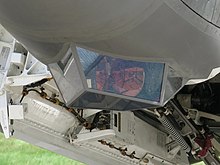The IRS is actually required to know, so you just said that Joe did not report his earnings.
You are as such a dumb shit
Well there you go again believing that I have to prove what I say when you do not.
Congress shall make no law respecting an establishment of religion, or prohibiting the free exercise thereof; or abridging the freedom of speech, or of the press; or the right of the people peaceably to assemble, and to petition the Government for a redress of grievances.
I can even discuss the AEGIS radar interception system, while you are a gagged idiot
The Aegis Combat System (ACS) implements advanced command and control (command and decision, or C&D, in Aegis parlance). It is composed of the Aegis Weapon System (AWS), the fast-reaction component of the Aegis Anti-Aircraft Warfare (AAW) capability, along with the
Phalanx Close In Weapon System (CIWS), and the
Mark 41 Vertical Launch System.
[2] Mk 41 VLS is available in different versions that vary in size and weight. There are three lengths: 209 in (5.3 m) for the self-defense version, 266 in (6.8 m) for the tactical version, and 303 in (7.7 m) for the strike version. The empty weight for an 8-cell module is 26,800 lb (12,200 kg) for the self-defense version, 29,800 lb (13,500 kg) for the tactical version, and 32,000 lb (15,000 kg) for the strike version, thus incorporating
anti-submarine warfare (ASW) systems and
Tomahawk Land Attack Cruise Missiles (TLAM). Shipboard torpedo and naval gunnery systems are also integrated.
AWS, the heart of Aegis, comprises the
AN/SPY-1 Radar, MK 99 Fire Control System, Weapon Control System (WCS), the Command and Decision Suite, and Standard Missile family of weapons; these include the basic
RIM-66 Standard, the
RIM-156 Standard ER extended range missile, and the newer
RIM-161 Standard Missile 3 designed to counter
ballistic missile threats. A further SM-2 based weapon, the
RIM-174 Standard ERAM (Standard Missile 6) was deployed in 2013. Individual ships may not carry all variants. Weapons loads are adjusted to suit assigned mission profile. The Aegis Combat System is controlled by an advanced, automatic detect-and-track, multi-function three-dimensional
passive electronically scanned array radar, the AN/SPY-1. Known as "the Shield of the Fleet", the SPY high-powered (6
megawatt) radar is able to perform search, tracking, and missile guidance functions simultaneously with a track capacity of well over 100 targets at more than 100 nautical miles (190 km).
[3] However, the AN/SPY-1 Radar is mounted lower than the
AN/SPS-49 radar system and so has a reduced
radar horizon.
[4]
The Aegis system communicates with the Standard missiles through a radio frequency (RF) uplink using the AN/SPY-1 radar for
mid-course update missile guidance during engagements, but still requires the
AN/SPG-62 fire-control radar for terminal guidance. This means that with proper scheduling of intercepts, a large number of targets can be engaged simultaneously.
The
computer-based command-and-decision (C&D) element is the core of the Aegis Combat System and came from the
Naval Tactical Data System (NTDS) threat evaluation and weapons assignment (TEWA) function.
[5] This interface makes the ACS capable of simultaneous operation against almost all kinds of threats.
In December 2019, Lockheed Martin released a promotional video heralding the 50th anniversary of the Aegis combat system.
LOL I dare you to discuss AEGIS
So what is it like being a retarded secret agent
130
![sleepy-smiley[1].gif sleepy-smiley[1].gif](https://www.houseofpolitics.com/data/attachments/12/12521-2b7ce5ceb658f6229da6bbc7ce2f7b89.jpg)
![Trump-Blaphemy-630x420[1].png Trump-Blaphemy-630x420[1].png](https://www.houseofpolitics.com/data/attachments/12/12522-bf8f0bff64c37ebd20e3c36b5c58027d.jpg)
![Trump-Blaphemy-630x420[1].png Trump-Blaphemy-630x420[1].png](https://www.houseofpolitics.com/data/attachments/12/12522-bf8f0bff64c37ebd20e3c36b5c58027d.jpg)

![Jim-Bakker[1].jpg Jim-Bakker[1].jpg](https://www.houseofpolitics.com/data/attachments/12/12520-688269c04de53f57a8716187a101a365.jpg)
